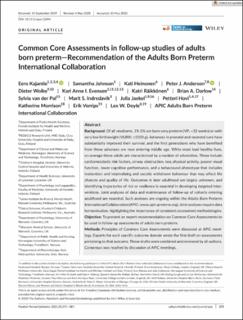| dc.contributor.author | Kajantie, Eero Olavi | |
| dc.contributor.author | Johnson, Samantha | |
| dc.contributor.author | Heinonen, Kati | |
| dc.contributor.author | Anderson, Peter J. | |
| dc.contributor.author | Wolke, Dieter | |
| dc.contributor.author | Evensen, Kari Anne Indredavik | |
| dc.contributor.author | Räikkönen, Katri | |
| dc.contributor.author | Darlow, Brian A. | |
| dc.contributor.author | Van Der Pal, Sylvia | |
| dc.contributor.author | Indredavik, Marit Sæbø | |
| dc.contributor.author | Jaekel, Julia | |
| dc.contributor.author | Hovi, Petteri | |
| dc.contributor.author | Morrison, Katherine M. | |
| dc.contributor.author | Verrips, Erik | |
| dc.contributor.author | Doyle, Lex W. | |
| dc.date.accessioned | 2022-02-18T12:54:29Z | |
| dc.date.available | 2022-02-18T12:54:29Z | |
| dc.date.created | 2020-09-30T12:43:07Z | |
| dc.date.issued | 2020-09-29 | |
| dc.identifier.issn | 0269-5022 | |
| dc.identifier.issn | 1365-3016 | |
| dc.identifier.uri | https://hdl.handle.net/11250/2980067 | |
| dc.description.abstract | Background: Of all newborns, 1%-2% are born very preterm (VP; <32 weeks) or with very low birthweight (VLBW; ≤1500 g). Advances in prenatal and neonatal care have substantially improved their survival, and the first generations who have benefited from these advances are now entering middle age. While most lead healthy lives, on average these adults are characterised by a number of adversities. These include cardiometabolic risk factors, airway obstruction, less physical activity, poorer visual function, lower cognitive performance, and a behavioural phenotype that includes inattention and internalising and socially withdrawn behaviour that may affect life chances and quality of life. Outcomes in later adulthood are largely unknown, and identifying trajectories of risk or resilience is essential in developing targeted interventions. Joint analyses of data and maintenance of follow-up of cohorts entering adulthood are essential. Such analyses are ongoing within the Adults Born Preterm International Collaboration (APIC; www.apic-preterm.org). Joint analyses require data harmonisation, highlighting the importance of consistent assessment methodologies.
Objective: To present an expert recommendation on Common Core Assessments to be used in follow-up assessments of adults born preterm.
Methods: Principles of Common Core Assessments were discussed at APIC meetings. Experts for each specific outcome domain wrote the first draft on assessments pertaining to that outcome. These drafts were combined and reviewed by all authors. Consensus was reached by discussion at APIC meetings.
Results: We present a recommendation by APIC experts on consistent measures to be used in adult follow-up assessments.
Conclusions: The recommendation encompasses both “core” measures which we recommend to use in all assessments of adults born preterm that include the particular outcome. This will allow comparability between time and location. The recommendation also lists optional measures, focusing on current gaps in knowledge. It includes sections on study design, cardiometabolic and related biomarkers, biological samples, life style, respiratory, ophthalmic, cognitive, mental health, personality, quality of life, sociodemographics, social relationships, and reproduction. | en_US |
| dc.language.iso | eng | en_US |
| dc.publisher | Wiley | en_US |
| dc.relation.ispartofseries | Paediatric and Perinatal Epidemiology;Volume 35, Issue 3 | |
| dc.rights | Navngivelse 4.0 Internasjonal | * |
| dc.rights.uri | http://creativecommons.org/licenses/by/4.0/deed.no | * |
| dc.subject | Recommendations | en_US |
| dc.subject | Birthweights | en_US |
| dc.subject | Preterm births | en_US |
| dc.subject | Follow-ups | en_US |
| dc.title | Common Core Assessments in follow‐up studies of adults born preterm—Recommendation of the Adults Born Preterm International Collaboration | en_US |
| dc.type | Peer reviewed | en_US |
| dc.type | Journal article | en_US |
| dc.description.version | publishedVersion | en_US |
| dc.rights.holder | © 2020 The Authors | en_US |
| cristin.ispublished | true | |
| cristin.fulltext | original | |
| cristin.qualitycode | 1 | |
| dc.identifier.doi | https://doi.org/10.1111/ppe.12694 | |
| dc.identifier.cristin | 1835543 | |
| dc.source.journal | Paediatric and Perinatal Epidemiology | en_US |
| dc.source.volume | 35 | en_US |
| dc.source.issue | 3 | en_US |
| dc.source.pagenumber | 371-387 | en_US |
| dc.relation.project | Norges forskningsråd: 283791 | en_US |
| dc.relation.project | EU/733280 | en_US |
| dc.subject.nsi | VDP::Medisinske fag: 700 | en_US |
| dc.subject.nsi | VDP::Midical sciences: 700 | en_US |

